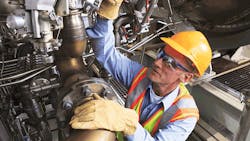How an Aging Workforce Will Affect Your Productivity and Safety (And What You Can Do About It)
By next year, one-third of the total U.S. workforce will be 50 years old or older, while workers within the skilled trades are retiring at a faster rate than other segments. China's over-65 population is projected to soar to 210 million by 2030. Across Latin America, birth rates have dropped 63 percent since 1960, and in Europe, employment initiatives and pension reforms will extend older workers' time in the workforce.
To compound the workforce availability pressures, more active workers will require time off to care for aging relatives. Two-thirds of current caregivers are working, and as many as 40 percent of them say they work in inflexible environments and have been forced to reduce their work hours or quit.
A growing labor pool historically has fueled global economic growth, but that fuel supply is in decline. Without an accelerated approach to productivity, the projected effect of the aging workforce will be a reduction in economic growth by 40 percent. To successfully address the profound demographic changes, manufacturers will have to reconsider machinery design methodologies, worker training, manufacturing intelligence and safety issues.
As the availability of workers shrinks, traditional productivity-improvement methods – offshoring, workforce mobility, etc. – become less effective. The problem must be dealt with by examining new approaches to productivity and safety features that address emerging workforce challenges.
Impact on Productivity and Safety
Productivity and safety go hand in hand and worker safety is becoming a more complex issue as demographics change.
Older workers bring a range of benefits – including experience – that reduces injury rates and training costs, but they are at higher risk for certain types of injuries. Although older Americans are healthier than ever, the aging body increases challenges.
Changes occur to skeletal muscle strength, vision and cognitive abilities. Range of motion, flexibility and dexterity decrease and can pose increasing challenges requiring precision movements. Recognition and analysis of hazards and reaction to those hazards can take longer. Lifting or carrying can become more challenging, making older workers more prone to musculoskeletal and repetitive stress injuries. Older workers also may take longer to recover from injuries than younger workers.
Several studies have shown that younger workers – under age 25 – and, in particular, those with less than one year on the job, not only have much higher injury rates but that those injuries tend to be more serious. This is attributed to inexperience, cognitive and developmental characteristics, hesitancy to ask questions, misjudgment of risks and failure to recognize workplace dangers.
Design, Safety and Improved Productivity
Manufacturers need to improve machinery design for the changing workforce. Younger and inexperienced workers need active safety systems to mitigate risks when they take inappropriate actions. These systems monitor machinery status and take action when there is an unsafe condition, such as when an operator or maintenance technician could place a body part in a hazardous position and be injured.
"This is a significant factor, having workers unfamiliar with the hazards of the industry and the jobs," said Bill Wilkerson, Cincinnati-area OSHA director, in a recent article in the Dayton Daily News. "It does create a larger burden on industry to train them both on the job and safety."
Older workers require less strenuous interaction with machinery and reduced lifting, bending, twisting and repetitive actions. This requires re-thinking how machinery is designed and built. Hazard assessments should take into account not only the traditional hazards, but ergonomic issues as well.
Engineers performing assessments, building functional specifications and designing machinery need to assess operator and maintenance technician movements as part of the process. They not only should review typical operator risks, but also ask additional questions:
Do operators have to lift materials? Could lifting be avoided by designing the machine differently?
Understanding that most injuries occur during non-standard operation, such as maintenance, do maintenance technicians have to bend or twist awkwardly when servicing the machine? Are technicians exposed to hazards during maintenance? How can these operations be performed more safely and more ergonomically?
Several studies by Aberdeen Group have shown that best-in-class manufacturers have 5 to 7 percent higher overall equipment effectiveness (OEE) and 2 to 4 percent less unscheduled downtime than their peers. These firms also had significantly fewer accidents and fewer repeat incidents.
Modern safety systems that are integrated with machinery control systems are very effective in mitigating risks while providing effective and productive machinery operation. Technologies such as safe-speed monitoring and zone control provide safe alternatives to lockout/tagout procedures, and integrated diagnostics reduce mean time to repair. These systems are not as prone to nuisance shutdowns as older systems, further improving productivity and safety.
Integrating Control and Information Systems
In the past, a facility's experienced maintenance person might be the only person with the institutional knowledge of how the control system works. When something fails, that person quickly could identify the problem and its cause. As those experts retire, they are not always replaced. Their workload might be divided among the remaining employees who may not have the same breadth of knowledge or skills.
Control system ease of use, programming and configuration will be the keys to get current and new workers up to speed and the facility back to optimum production. A safety automation system and other machine diagnostics and intelligence can provide insight into machinery operation and fault detection, reducing the time to recover and resume production.
Machine builders should consider both ergonomics and active safety systems when designing machinery, and manufacturers should demand machinery designs that accommodate the physical limitations of aging workers. The evolution of machinery design will require time, but such requirements should be built into all new machinery specifications.
Leverage External Resources to Augment Competencies
For specialized skills that only occasionally are required, it may make sense to build relationships with experts and use their consulting or technical services on an as-needed basis. Safety consulting and assessment services, systems integration services and even some specialized maintenance services with a deep knowledge base in the area of need can provide a "fresh" view of circumstances.
Making safe, productive changes to the manufacturing work environment will take time, but will help enhance the sustainability of operations. Moreover, making these changes to create an informed, competent, safe, sustainable workforce will pay off in higher morale and an improved culture throughout the organization, while providing the accelerated productivity needed to address new and emerging workforce challenges.
Steve Ludwig is the safety programs manager for Rockwell Automation.

